Marine Biology in Alaska 2013
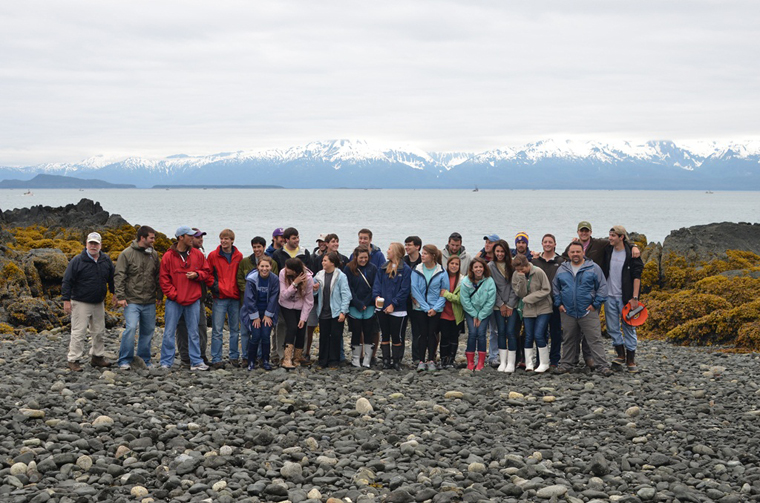 Marine Biology in Southeast Alaska July 19- August 10, 2013
Marine Biology in Southeast Alaska July 19- August 10, 2013
Why Should You Go to Southeast Alaska?
Alaska is the last Frontier of North America and has as much shoreline as the entire continental United States. Alaska also lands the most pounds of fish and Alaska the most valuable fishery in the United States. Louisiana ranks second among the states in pounds of fish captured and fourth and fourth in the value of their landings.
The program is very affordable and safe. A two and a half day ferry trip on the MV Columbia between Bellingham WA and Auke Bay, AK will begin the course. We will stay and eat at the University of Alaska Southeast campus. A marine mammal watching cruise to observe humpback whales and Stellar Sea Lions, a cruise to Tracy Arm with the tidewater South Sawyer glacier and Harbor seals, and a hike to the ice caves of the Mendenhall Glacier are also included in the program.
Experts from the National Marine Fisheries Service Laboratory at Lena Point, The University of Alaska’s School of Fisheries, The National Park Service Visitor’s Center at the Mendenhall Glacier, and The Alaska State Museum will give presentations.
You will have a unique opportunity to study the North Pacific Ocean and Temperate Rain Forest Ecosystem and become familiar with marine mammals, fish and invertebrates including the five species of commercially important salmon. You can also gain expertise and academic credit in Neurobiology. You will also gain an in depth understanding of the ecological impact of the Exxon Valdez oil spill on the Prince William Sound Ecosystem in comparison with the Deepwater Horizon oil leak.
You will have an opportunity to take part in a number of recreational activities during your spare time. Students frequently hike the 300 miles of trails in the Tongass National Forest, kayak, fish, zipline, work out at the student Recreation Center and visit Juneau, the state capital. For a student’s perspective of their experience in the program go to this document (PDF)
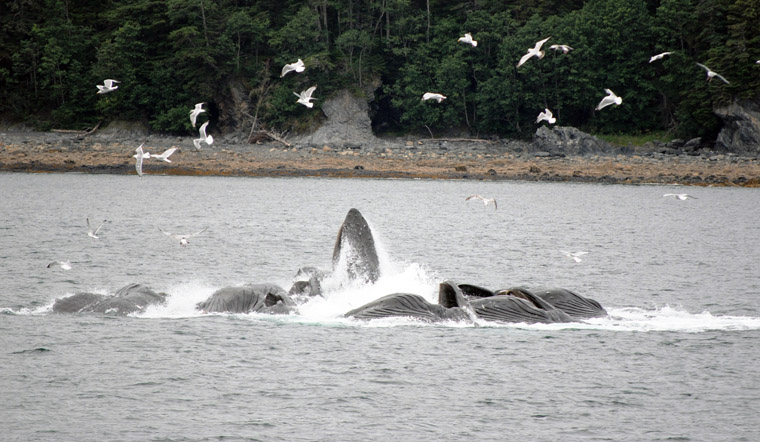 Bubblenet feeding Humpback Whales seen on our mammal watching cruise in Lynn Canal.
Bubblenet feeding Humpback Whales seen on our mammal watching cruise in Lynn Canal.
 Courses Offered
Courses Offered
Students should enroll in 6-7 credit hours from the following course offerings:
Biol. 4262 – Marine Communities (3) Syllabus, Paper and PowerPoint Guidelines
Biol. 4263 – Marine Communities lab (1) Syllabus, PowerPoint 1, PowerPoint 2
Biol. 4177 – Neurobiology (3) Syllabus Biol. 3999 – Undergraduate Research (1-3) Syllabus, Paper Guidelines
Biol. 3999 – Undergraduate Research (1-3) Syllabus, Paper Guidelines
Prerequisite for Biol 4262 and 4263 is Genetics (Biol. 2153).
Prerequisites for Biol. 4177 is BIOL 3090 or 4087 or 4093 and CHEM 2262 or 2462
Prerequisites for Biol 3999 – permission of the Department.
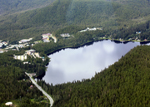
Location
This program will begin with a two day ferry ride between Bellingham Washington and Auke Bay Alaska which is just north of Juneau. We will stay and eat on the University of Alaska Southeast campus. Classes will be held on the UAS campus, at the University of Alaska Fairbanks School of Fisheries Building, at the NMFS laboratory, and in the field. We will be located just north of Juneau which is the capital of Alaska.
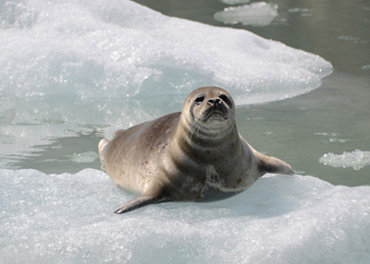
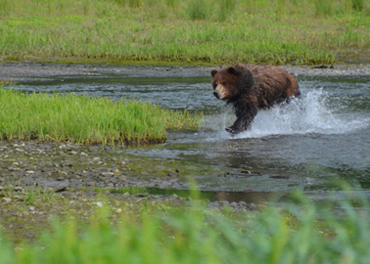
Expected Cost
Program fee is $3750 plus tuition, airfare, and spending money. Students should bring $700-$900 for discretionary spending. This fee covers accommodations in a dormitory with two two-bed bedrooms and a bathroom per unit. Each unit will have a small refrigerator. You will receive three meals per day M-F and breakfast and lunch on Saturday. Ground transportation to off campus class activities is provided. Students should bring a laptop computer.
Financial Aid
Federal Student Aid May Apply
See Student Aid and Scholarships for more details.
Faculty
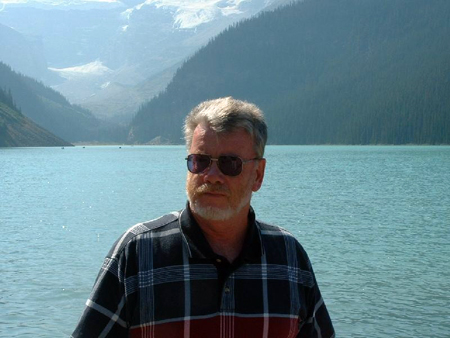 Dr. Bill Stickle, who arrived at LSU in 1972, has conducted research in the northern
Gulf of Mexico and the Pacific Northwest since 1967. He developed and taught the LSU
Marine Biology in southeast Alaska program in June of 2008 and 2009 and July 2010
where he developed contacts and successfully interacted with the people and facilities
listed in this proposal. He has a long-term research collaboration with Dr. Stanley
Rice who is Head of the Marine Habitat Program at the NMFS laboratory in Auke Bay/Lena
Point. Five other research staff from the NMFS facility and two faculty from the School
of Fisheries have given lectures to the LSU students. Bill Stickle also developed
the Marine Communities class and laboratory at LSU (Biol. 4262 and 4263) and has taught
Marine Biology for two summers at the Pennsylvania Marine Science Consortium at Delaware
Bay and Wallops Island Virginia so he has ample experience in teaching at Marine Stations.
He has graduated 15 MS and 11 PhD students.
Dr. Bill Stickle, who arrived at LSU in 1972, has conducted research in the northern
Gulf of Mexico and the Pacific Northwest since 1967. He developed and taught the LSU
Marine Biology in southeast Alaska program in June of 2008 and 2009 and July 2010
where he developed contacts and successfully interacted with the people and facilities
listed in this proposal. He has a long-term research collaboration with Dr. Stanley
Rice who is Head of the Marine Habitat Program at the NMFS laboratory in Auke Bay/Lena
Point. Five other research staff from the NMFS facility and two faculty from the School
of Fisheries have given lectures to the LSU students. Bill Stickle also developed
the Marine Communities class and laboratory at LSU (Biol. 4262 and 4263) and has taught
Marine Biology for two summers at the Pennsylvania Marine Science Consortium at Delaware
Bay and Wallops Island Virginia so he has ample experience in teaching at Marine Stations.
He has graduated 15 MS and 11 PhD students.
 Dr. John Caprio arrived at LSU in 1976 and conducted research on the chemical senses
(taste & smell) in fish. His laboratory investigated the sensitivity and specificity
of the olfactory and gustatory systems of different species of fishes and how chemical
stimuli are processed by the nervous system. The research was funded for 30 years
from various grants from the National Institutes of Health, the National Science Foundation
and the Naval Research Laboratory. At LSU, he has taught courses in Neurobiology,
Vertebrate Physiology, Human Physiology and General Biology. Dr. Caprio is also past
president of the National Association of the Society for Chemoreception Sciences,
was the recipient of the prestigious LSU Research Master’s Award and has received
College teaching awards. Commercial spinoffs of his basic research include the development
of chemical sense sportfishing lures.
Dr. John Caprio arrived at LSU in 1976 and conducted research on the chemical senses
(taste & smell) in fish. His laboratory investigated the sensitivity and specificity
of the olfactory and gustatory systems of different species of fishes and how chemical
stimuli are processed by the nervous system. The research was funded for 30 years
from various grants from the National Institutes of Health, the National Science Foundation
and the Naval Research Laboratory. At LSU, he has taught courses in Neurobiology,
Vertebrate Physiology, Human Physiology and General Biology. Dr. Caprio is also past
president of the National Association of the Society for Chemoreception Sciences,
was the recipient of the prestigious LSU Research Master’s Award and has received
College teaching awards. Commercial spinoffs of his basic research include the development
of chemical sense sportfishing lures.